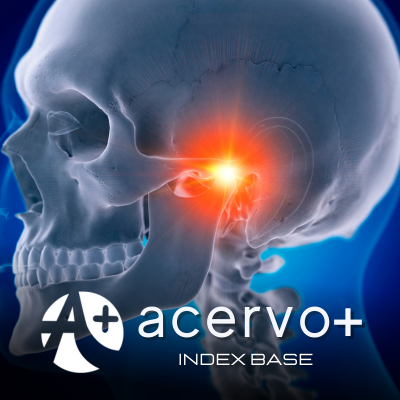Sinais e sintomas clínicos de cefaleias em indivíduos com disfunção temporomandibular
##plugins.themes.bootstrap3.article.main##
Resumo
Objetivo: Caracterizar indivíduos com DTM atendidos em Serviço de Dor Orofacial, durante o período de 2020 a 2023, acerca de sinais e sintomas de cefaleias. Métodos: Tratou-se de um estudo documental observacional transversal retrospectivo. A amostra foi composta por sessenta prontuários de indivíduos com DTM e sinais e sintomas de cefaléia atendidos no curso de Odontologia da Universidade Federal do Ceará. Os dados foram tabulados utilizando estatística descritiva. Resultados: Verificou-se que os indivíduos mais afetados são mulheres pardas, com idade maior ou igual a 30 anos. Na maior parte da amostra, as cefaleias tiveram início há mais de um ano, eram descritas como moderadas a severas, com duração constante ou de horas, bilaterais ou de localizações variadas e mais frequentemente descritas como pressão/apertada. Os diagnósticos prévios de cefaleia mais prevalentes foram de Cefaleia Tipo Tensão e migrânea e metade da amostra apresentava cefaleia secundária à DTM. Conclusão: Nossos achados corroboram com os descritos na literatura e sugerem a necessidade de políticas de saúde pública que visem o diagnóstico precoce de cefaleias em indivíduos com DTM.
##plugins.themes.bootstrap3.article.details##
Copyright © | Todos os direitos reservados.
A revista detém os direitos autorais exclusivos de publicação deste artigo nos termos da lei 9610/98.
Reprodução parcial
É livre o uso de partes do texto, figuras e questionário do artigo, sendo obrigatória a citação dos autores e revista.
Reprodução total
É expressamente proibida, devendo ser autorizada pela revista.
Referências
2. BRANCO RS, et al. Freqüência de relatos de parafunções nos subgrupos diagnósticos de DTM de acordo com os critérios diagnósticos para pesquisa em disfunções temporomandibulares (RDC/TMD). Revista Dental Press de Ortodontia e Ortopedia Facial, 2008; 13(2): 61–9.
3. BALLEGAARD V, et al. Are headache and temporomandibular disorders related? A blinded study. Cephalalgia, 2008; 28(8): 832-841.
4. CHAVES TC, et al. Concomitant migraine and temporomandibular disorders are associated with higher heat pain hyperalgesia and cephalic cutaneous allodynia. The Clinical journal of pain, 2016; 32(10): 882–888.
5. CHICHORRO JG, et al. Mechanisms of craniofacial pain. Cephalalgia, 2017; 37(7): 613–626.
6. CONTI, P. C. R. Disfunções Temporomandibulares e Dores Orofaciais: Aplicação Clínica das Evidências Científicas. 1a ed. Maringá: DentalPress, 2021.
7. CONTRERAS EFR, et al. Systemic diseases and other painful conditions in patients with temporomandibular disorders and migraine. Brazilian oral research, 2018; 32: 77.
8. COSTA YM, et al. Headache Attributed to Masticatory Myofascial Pain: Clinical Features and Management Outcomes. Journal of Oral & Facial Pain & Headache, 2015; 29(4): 323-330.
9. COSTA, YM, et al. Introdução ao estudo da dor: mecanismos básicos da dor orofacial. In: DTM disfunções temporomandibulares e dores orofaciais: aplicação clínica das evidências científicas. Maringá: Dental Press, 2021; 477.
10. DE PAIVA BERTOLI FM, et al. Anxiety and malocclusion are associated with temporomandibular disorders in adolescents diagnosed by RDC/TMD. A cross‐sectional study. Journal of Oral Rehabilitation, 2018; 45(10): 747-755.
11. DUBNER R, REN K,et al. Brainstem mechanisms of persistent pain following injury. Journal of orofacial pain, 2004; 18(4): 299 –305.
12. FERNANDES G, et al. Painful temporomandibular disorder is associated with migraine in adolescents: a case-control study. The Journal of Pain, 2019; 20(10): 1155–1163.
13. FIAMENGUI LMSP, et al. The influence of myofascial temporomandibular disorder pain on the pressure pain threshold of women during a migraine attack. Journal of Orofacial Pain, 2013; 27(4): 343–9.
14. FRAGOSO YR, et al. Prevalence of parafunctional habits and temporomandibular dysfunction symptoms in patients attending a tertiary headache clinic. Arquivos de neuropsiquiatria, 2010; 68: 377–380.
15. FRANCO AL, et al. Migraine is the most prevalent primary headache in individuals with temporomandibular disorders. Journal of orofacial pain, 2010; 24(3): 287–92.
16. GONÇALVES DAG, et al. Cefaleias primárias e a associação com as DTM: conceitos básicos de interesse clínico. In: CONTI PCR, et al. Disfunção Temporomandibular (DTM) e Dores Orofaciais: aplicação clínica das evidências científicas. Dental Press, 2021; 17: 477.
17. GONÇALVES DAG, et al. Symptoms of Temporomandibular Disorders in the Population: An Epidemiological Study. Journal Of Orofacial Pain, 2010; 24(3): 270–278.
18. GONÇALVES DAG, et al. Temporomandibular disorders are differentially associated with headache diagnoses: a controlled study. The Clinical journal of pain, 2011; 27(7): 611–615.
19. GONÇALVES DAG, et al. Treatment of comorbid migraine and temporomandibular disorders: a factorial, double-blind, randomized, placebo-controlled study. Journal of orofacial pain, 2013; 27(4): 325–335.
20. INTERNATIONAL HEADACHE SOCIETY. The international classification of headache disorders. 3 ed. Cephalalgia, 2018; 38(1): 1-211.
21. MERRILL RL,et al. Central mechanisms of orofacial pain. Dental Clinics, 2007; 51(1): 45-.
22. NASRI-HEIR, CIBELE EPSTEIN, JOEL B, TOUGER-DECKER, RIVA, BENOLIEL, RAFAEL, et al. What should we tell patients with painful temporomandibular disorders about what to eat? The Journal Of The American Dental Association, 2016; 147(8): 667-671.
23. FACIAL PAIN. National Institute of Dental and Craniofacial Research, 2018.
24. OKESON JP. Tratamento das desordens temporomandibulares e oclusão. 7 ed. Rio de Janeiro: Mosby Elsevier, 2013.
25. PINTO LMS, et al. Influence of myofascial pain on the pressure pain threshold of masticatory muscles in women with migraine. The Clinical journal of pain, 2013; 29(4): 362-365.
26. PORPORATTI AL, et al. Primary headaches interfere with the efficacy of temporomandibular disorders management. Journal of Applied Oral Science, 2014; 23(2): 129-134.
27. SCHIFFMAN E, et al. Diagnostic Criteria for Temporomandibular Disorders (DC/TMD) for Clinical and Research Applications: recommendations of the international rdc/tmd consortium network* and orofacial pain special interest group. Journal Of Oral & Facial Pain And Headache, 2014; 28(1): 6-27.
28. SPECIALI JG. Cefaleias. Ciência e Cultura, 2011; 63 (2): 38-42.
29. STOVNER LJ, et al. The global burden of headache: a documentation of headache prevalence and disability worldwide. Cephalalgia, 2007; 27(3): 193-210.
30. TOMAZ-MORAIS JF, et al. Temporomandibular disorder is more prevalent among patients with primary headaches in a tertiary outpatient clinic. Arquivos de neuropsiquiatria, 2015; 73(11): 913-917.

